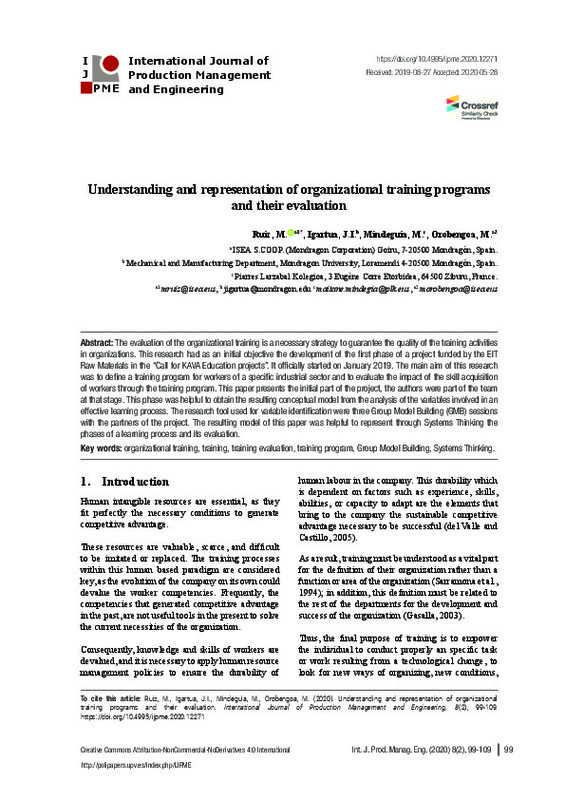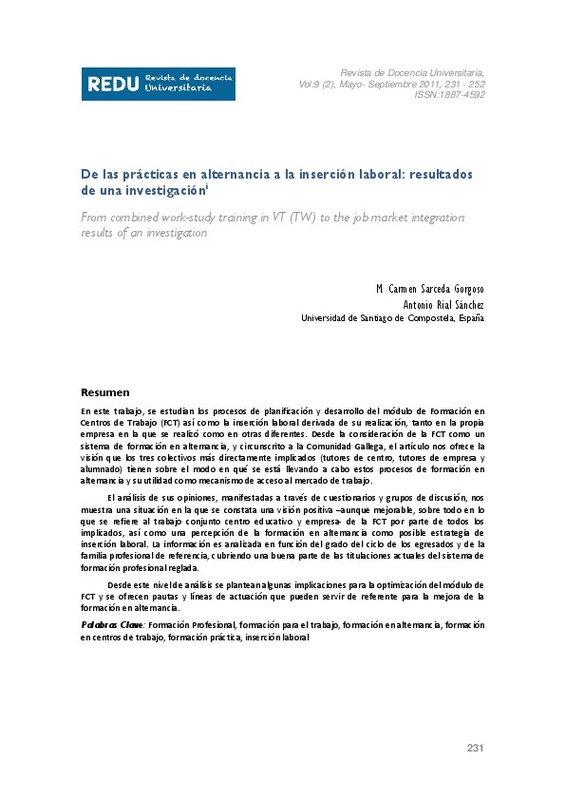JavaScript is disabled for your browser. Some features of this site may not work without it.
Buscar en RiuNet
Listar
Mi cuenta
Estadísticas
Ayuda RiuNet
Admin. UPV
Understanding and representation of organizational training programs and their evaluation
Mostrar el registro sencillo del ítem
Ficheros en el ítem
| dc.contributor.author | Ruiz, M.
|
es_ES |
| dc.contributor.author | Igartua, J.I.
|
es_ES |
| dc.contributor.author | Mindeguia, M.
|
es_ES |
| dc.contributor.author | Orobengoa, M.
|
es_ES |
| dc.date.accessioned | 2020-07-23T09:58:09Z | |
| dc.date.available | 2020-07-23T09:58:09Z | |
| dc.date.issued | 2020-07-18 | |
| dc.identifier.uri | http://hdl.handle.net/10251/148541 | |
| dc.description.abstract | [EN] The evaluation of the organizational training is a necessary strategy to guarantee the quality of the training activities in organizations. This research had as an initial objective the development of the first phase of a project funded by the EIT Raw Materials in the “Call for KAVA Education projects”. It officially started on January 2019. The main aim of this research was to define a training program for workers of a specific industrial sector and to evaluate the impact of the skill acquisition of workers through the training program. This paper presents the initial part of the project, the authors were part of the team at that stage. This phase was helpful to obtain the resulting conceptual model from the analysis of the variables involved in an effective learning process. The research tool used for variable identification were three Group Model Building (GMB) sessions with the partners of the project. The resulting model of this paper was helpful to represent through Systems Thinking the phases of a learning process and its evaluation. | es_ES |
| dc.language | Inglés | es_ES |
| dc.publisher | Universitat Politècnica de València | es_ES |
| dc.relation.ispartof | International Journal of Production Management and Engineering | es_ES |
| dc.rights | Reconocimiento - No comercial - Sin obra derivada (by-nc-nd) | es_ES |
| dc.subject | Organizational training | es_ES |
| dc.subject | Training | es_ES |
| dc.subject | Training evaluation | es_ES |
| dc.subject | Training program | es_ES |
| dc.subject | Group Model Building | es_ES |
| dc.subject | Systems Thinking | es_ES |
| dc.title | Understanding and representation of organizational training programs and their evaluation | es_ES |
| dc.type | Artículo | es_ES |
| dc.identifier.doi | 10.4995/ijpme.2020.12271 | |
| dc.rights.accessRights | Abierto | es_ES |
| dc.description.bibliographicCitation | Ruiz, M.; Igartua, J.; Mindeguia, M.; Orobengoa, M. (2020). Understanding and representation of organizational training programs and their evaluation. International Journal of Production Management and Engineering. 8(2):99-109. https://doi.org/10.4995/ijpme.2020.12271 | es_ES |
| dc.description.accrualMethod | OJS | es_ES |
| dc.relation.publisherversion | https://doi.org/10.4995/ijpme.2020.12271 | es_ES |
| dc.description.upvformatpinicio | 99 | es_ES |
| dc.description.upvformatpfin | 109 | es_ES |
| dc.type.version | info:eu-repo/semantics/publishedVersion | es_ES |
| dc.description.volume | 8 | es_ES |
| dc.description.issue | 2 | es_ES |
| dc.identifier.eissn | 2340-4876 | |
| dc.relation.pasarela | OJS\12271 | es_ES |
| dc.description.references | Agnaia, A.A. (1996). Assessment of Management Training Needs and Selection for Training: The Case of Libyan Companies. International Journal of Manpower, 17(3), 31-52. https://doi.org/10.1108/01437729610119504 | es_ES |
| dc.description.references | Al-Khayyat, R. (1998). Training and Development Needs Assessment: A Practical Model for Partner Institutes. Journal of European Industrial Training, 22(1), 18-28. https://doi.org/10.1108/03090599810197658 | es_ES |
| dc.description.references | Alliger, G.M., Tannenbaum, S.I., Bennett, W., Traver, H., Shotland, A. (1997). A Meta- Analysis of the Relations among Training Criteria. Personnel Psychology, 50, 341-58. https://doi.org/10.1111/j.1744-6570.1997.tb00911.x | es_ES |
| dc.description.references | Alsina, M.I.B., Rodriguez, F.A.C. (2001). Estrategias de evaluación de los aprendizajes centradas en el proceso. Revista española de pedagogía ,25-48. | es_ES |
| dc.description.references | Alvarez, K., Salas, E., Garofano, C.M. (2004). An integrated model of training evaluation and effectiveness. Human resource development Review, 3(4), 385-416. https://doi.org/10.1177/1534484304270820 | es_ES |
| dc.description.references | Aragón-Sánchez, A., Barba-Aragón, I., Sanz-Valle, R. (2003). Effects of training on business results. The International Journal of Human Resource Management, 14(6), 956-980. https://doi.org/10.1080/0958519032000106164 | es_ES |
| dc.description.references | Arnold, R.D., Wade, J.P. (2015). A definition of systems thinking: A systems approach. Procedia Computer Science, 44(2015), 669-678. https://doi.org/10.1016/j.procs.2015.03.050 | es_ES |
| dc.description.references | Bassi, L.J., Ludwig, J., McMurrer, D.P., Van Buren, M. (2002). Profiting from learning: firm-level effects of training investments and market implications. Singapore Management Review, 24(3), 61-80. | es_ES |
| dc.description.references | Bee, F., Bee, R. (1997). Training Needs Analysis and Evaluation. London: Institute of Personnel and Development. | es_ES |
| dc.description.references | Brown, K.G., Gerhardt, M.W. (2002). Formative evaluation: An integrative practice model and case study. Personnel Psychology, 55, 951-983. https://doi.org/10.1111/j.1744-6570.2002.tb00137.x | es_ES |
| dc.description.references | Buckley, R., Caple, J. (1991). La formación: Teoría and práctica. Madrid: Díaz de Santos. | es_ES |
| dc.description.references | del Valle, I.D., Castillo, M.Á.S. (2005). Problemas y propuestas de medición de la formación en la empresa/Problems and measuring proposals for company training. Cuadernos de estudios empresariales, 15, 27. | es_ES |
| dc.description.references | Desimone, R.L., Werner, J.M., Harris, D.M. (2002). Human resource development. Cincinnati, OH: South Western. | es_ES |
| dc.description.references | Dickenson, P., Blundell, B. (2000). Transferring Quality Management Experience to the Russian Aerospace Industry. Total Quality Management, 11(3), 319-27. https://doi.org/10.1080/0954412006838 | es_ES |
| dc.description.references | Foot, M., Hook, C. (1996). Introducing Human Resource Management. Singapore: Longman. | es_ES |
| dc.description.references | Frazis, H., Gittleman, M., Horrigan, M., Joyce, M. (1998). Results from the 1995 Survey of Employer-Provided Training. Monthly Labor Review, 121(6), 3-13. | es_ES |
| dc.description.references | Gasalla, J.M. (2003). Marketing de la formación de directivos: el nuevo directivo en la cultura del aprendizaje. Madrid: Pirámide. | es_ES |
| dc.description.references | Goldstein, I.L. (1993). Training in Organizations. Pacific Grove, CA: Brooks/Cole. | es_ES |
| dc.description.references | Gray, G.R., Hall, M.E. (1997).Training Practices in State Government Agencies. Public Personnel Management, 26(2), 187-203. https://doi.org/10.1177/009102609702600203 | es_ES |
| dc.description.references | Hamblin, A.C. (1974). Evaluation and Control of Training. Maidenhead: McGraw-Hill. | es_ES |
| dc.description.references | Hannum,W., Hansen, C. (1989). Instructional systems development in large organizations. Englewood Cliffs, NJ: Educational Technology Publications. | es_ES |
| dc.description.references | Herrero, P.P. (2000). Evaluación del impacto de la formación de las organizaciones. Educar, (27), 119-133. | es_ES |
| dc.description.references | Holton, E.F. (2000). Large-scale Performance-Driven Training Needs Assessment. Public Personnel Management, 29(2), 249-67. https://doi.org/10.1177/009102600002900207 | es_ES |
| dc.description.references | Hoppenbrouwers, S., Rouwette, E. (2012). A dialogue game for analysing group model building: framing collaborative modelling and its facilitation. International Journal of Organisational Design and Engineering, 2(1), 19-40. https://doi.org/10.1504/IJODE.2012.045905 | es_ES |
| dc.description.references | Kaufman, R., Keller, J.M. (1994). Levels of Evaluation: Beyond Kirkpatrick. Human Resource Development Quarterly, 5(4), 371-80. https://doi.org/10.1002/hrdq.3920050408 | es_ES |
| dc.description.references | Kenney, J., Donnelly, P. (1976). Manpower Training and Development. Londres: Harrap. | es_ES |
| dc.description.references | Kirkpatrick, D. (1997). Revisando las Grandes Ideas. Training & Development Digest, September: 28-36. | es_ES |
| dc.description.references | Kirkpatrick, J.D., Kirkpatrick, W.K. (2016). Kirkpatrick's four levels of training evaluation. Association for Talent Development. | es_ES |
| dc.description.references | Kraiger, K., Ford, J.K., Salas, E. (1993). Application of cognitive, skill-based, and affective theories of learning outcomes to new methods of training evaluation. Journal of Applied Psychology, 78, 311-328. https://doi.org/10.1037/0021-9010.78.2.311 | es_ES |
| dc.description.references | Legare, T.L. (1999). Defining Training Roles and Responsibilities at Partners Healthcare System. National Productivity Review, 19(1), 5-13. https://doi.org/10.1002/npr.4040190103 | es_ES |
| dc.description.references | McGehee, R., Thayere, J. (1961) Training in Business and Industry. New York: John Wiley. | es_ES |
| dc.description.references | Moller, L., Mallin, P. (1996). Evaluation practices of instructional designers and organizational support or barriers. Performance Improvement Quarterly, 9(4), 82-92. https://doi.org/10.1111/j.1937-8327.1996.tb00740.x | es_ES |
| dc.description.references | Nadler, Z., Nadler, L. (2012). Designing training programs. Routledge. https://doi.org/10.4324/9780080503974 | es_ES |
| dc.description.references | Oberman, G. (1996). An Approach for Measuring Safety Training Effectiveness. Occupational Health & Safety, 65(12), 48-58. | es_ES |
| dc.description.references | O'Neill, M. (1998). Cómo enfocar la evaluación de la formación. Info-line (American Society for Training and Development), 1(special issue), 1-18. | es_ES |
| dc.description.references | Phillips, J.J. (2012). Return on investment in training and performance improvement programs. Routledge. https://doi.org/10.4324/9780080516257 | es_ES |
| dc.description.references | Phillips, J.J., Phillips, P.P. (2016). Handbook of training evaluation and measurement methods. Routledge. https://doi.org/10.4324/9781315757230 | es_ES |
| dc.description.references | Pineda, P. (1998). El reto de evaluar la formación en la empresa: Herramientas and soluciones. Capital Humano, 111, 32-6. | es_ES |
| dc.description.references | Plant, R.A., Ryan, R.J. (1992).Training Evaluation: A Procedure for Validating an Organizations Investment in Training. Journal of European Industrial Training, 16(10), 22-38. https://doi.org/10.1108/03090599210021720 | es_ES |
| dc.description.references | Sarramona, J., Colom, A, Vázquez, G (1994). Estrategias de formación en la empresa. Narcea. | es_ES |
| dc.description.references | Selmer, J. (2000). A Quantitative Needs Assessment Technique for Cross-Cultural Work Adjustment Training. Human Resource Development Quarterly, 11(3), 269-282. https://doi.org/10.1002/1532-1096(200023)11:3%3C269::AID-HRDQ5%3E3.0.CO;2-6 | es_ES |
| dc.description.references | Spitzer, D.R. (1999). Embracing evaluation. Training, 36(6), 42-47. | es_ES |
| dc.description.references | Swanson, R.A. (2005). Evaluation, a state of mind. Advances in Developing Human Resources, 7(1), 16-21. https://doi.org/10.1177/1523422304272078 | es_ES |
| dc.description.references | Tannenbaum, S.I., Woods, S.B. (1992). Determining a Strategy for Evaluating Training: Operating within Organizational Constraints. Human Resource Planning, 15(2), 63-82. | es_ES |
| dc.description.references | Wang, G.G., Wilcox, D. (2006). Training evaluation: knowing more than is practiced. Advances in Developing Human Resources, 8(4), 528-539. https://doi.org/10.1177/1523422306293007 | es_ES |











